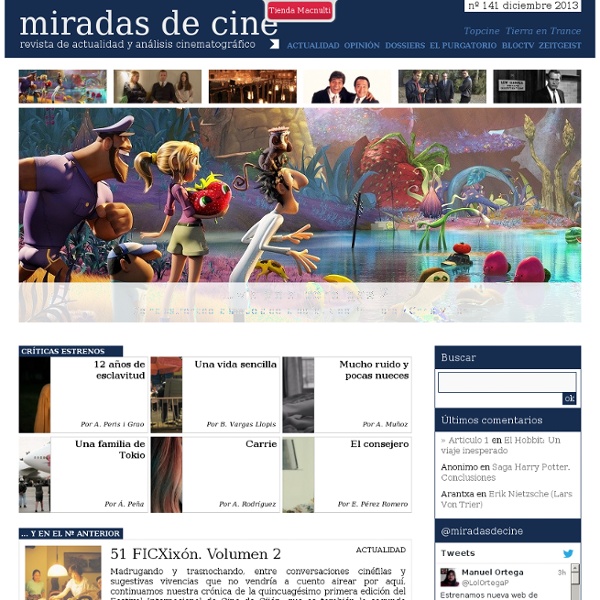



Fellini - "8 ½" (1963) Nos hallamos ante la obra más prestigiosa de Federico Fellini. La que se encuentra en muchas listas como una de las diez mejores películas de la historia del cine. En los comentarios que acompañan a la lista confeccionada por Sight and Sound se apunta que Ocho y medio (8 ½, 1963) es especialmente valorada por los realizadores de cine. No debería extrañarnos demasiado. Ocho y medio habla sobre la creación cinematográfica, más aún, sobre el creador, el artista. El arranque de Ocho y Medio sintetiza a la perfección el discurso que se irá adornando (ya que se construye completo en el inicio) a lo largo de toda la película. Este principio es todo Fellini, es todo Ocho y Medio . Este inicio de tintes surrealistas y ambiente onírico propios de una ensoñación será la norma según la cual Fellini da la espalda a la realidad. Esa distancia con respecto a la realidad también se manifiesta en la ausencia de elementos referenciales de una época.
Críticas de películas y estrenos. Blog de cine Bright Lights Film Journal Train to Somewhere Hou Hsiao-hsien Pays Sweet Homage to Ozu in Café Lumière Hou honors the master while remaining true to his own vision The 100th anniversary of the birth of Yasujiro Ozu on December 12, 1903 has seen the release of films by two major international art cinema directors — Abbas Kiarostami and Hou Hsiao-hsien — that are explicit homages to Ozu. In the case of Kiarostami's Five (2003), the connection with Ozu is remote to say the least: a 74-minute film consisting of five static shots of the seashore, its willful denial of Kiarostami's own strengths as a narrative filmmaker makes it little more than an interesting experiment, more at home in the art gallery than the cinema. And the connection with Ozu? Café Lumière (2003) is another case entirely. So in Café Lumière there are some parallels with Ozu's world, but there is also considerable distance, just as there is distance between the films of Ozu and those of Hou. And what of the story itself?
Redes sociales para alimentar la seriefilia >> Quinta Temporada Surgen como setas; cada poco tiempo hay una nueva. El número de opciones que nos permiten unir dos de las pasiones que hacen furor en Internet, las redes sociales y las series, es cada vez mayor. MyTVShows, Espoilertv, Clicker, Miso, GetGlue, Qvemos.com, Series.ly... Se parecen, pero ninguna es igual a la otra. En la mayoría de los casos, las plataformas sociales orientadas al mundo seriéfilo (unido muchas veces a otros campos de la ficción, como el cine o los videojuegos) se quedan en una simple agenda online donde ir apuntando las series que sigues y los capítulos que has visto. La base de una "red social" es, precisamente, facilitar el contacto y compartir opiniones entre los fans. GetGlue se mueve en la misma línea que Miso en cuanto a la relación con los lugares donde realmente vamos a comentar las series (Twitter y Facebook) y los puntos por tu actividad. Series.ly Vamos con el producto nacional. Qvemos.com
Millennium Mambo review - movie review of the Hsiao-hsien Hou fi Millennium Mambo Directed by Hsiao-hsien Hou As Millenium Mambo opens, following Vicky (Qi Shu) as she walks with an ecstatic grace on a bridge, almost floating in complete silence, you get instantly taken by the beauty of the scene, getting the feeling you're in for something unique. And it is. Veteran director Hsiao-hsien Hou, better known for melodramas such as The Puppetmaster and Flowers of Shanghai , has crafted a gorgeous and poetic film, which almost stands still, as the setting—mostly reduced to an apartment—and the story—a girl in a passive-abusive relationship—are almost inexistent. Bathed in vibrant colors and supported by a chill-out electronic soundtrack, Millenium Mambo is, rather than a picture, an experience, which aims at brushing against the emotional state of its central character, to absorb her beauty and vacuity without interfering, like in some sort of naturalist painting. Fred Thom